Glam rock, a genre that burst into the musical mainstream in the early 1970s, was as much about the spectacle as it was about the sound. Characterized by its flamboyant aesthetics, theatricality, and an embrace of androgyny and exaggeration, glam rock broke through the countercultural waves of the ’60s to herald a new era of musical performance and persona. This genre melded diverse musical influences—from rock and roll to cabaret, and from art rock to pop—creating a sonic palette that was both eclectic and highly accessible. Its artists donned glitter, sequins, and platform shoes, turning concert stages into canvases for performance art that captivated and often shocked audiences.
Within this vibrant scene, Roxy Music emerged not merely as participants but as pioneering architects who redefined the boundaries and potential of glam rock. From their inception, Roxy Music injected a sophisticated blend of style and substance into the genre, setting new standards for musical innovation and theatrical presentation. Their influence was profound, crafting a version of glam that was as cerebral as it was sensational, and as musically intricate as it was visually extravagant. Explore how Roxy Music, through their distinctive approach to music and performance, came to embody the spirit of glam rock and significantly shaped its evolution, leaving a lasting impact on popular music that resonates to this day.
The Glam Rock Landscape Before Roxy Music

Early Pioneers
Before Roxy Music carved their niche, the glam rock stage was set by a cadre of audacious pioneers, among whom David Bowie and T. Rex were the most flamboyant and influential. David Bowie, with his myriad personas—most notably Ziggy Stardust—ushered in a new era of rock music that was as much about the identity of the performer as it was about the music. His albums like “The Rise and Fall of Ziggy Stardust and the Spiders from Mars” were not just collections of songs but declarations of artistic freedom and self-expression.
Similarly, Marc Bolan of T. Rex brought a fantastical, almost mythical element to glam rock. His electric performances and chart-topping hits like “Bang a Gong (Get It On)” and “Children of the Revolution” captivated a generation, making glam rock a dominant force in the UK charts.
Cultural and Musical Backdrop
The early 1970s were a time of significant socio-cultural change. The post-1960s landscape was one of disillusionment with more traditional post-war values and a burgeoning desire among the youth to redefine norms of identity and expression. Glam rock resonated in this climate by challenging conventional gender roles and societal expectations with its androgynous stars, theatrical excess, and lyrical escapism.
Musically, the era was ripe for innovation. The late 1960s had seen the psychedelic rock scene morph into various sub-genres, creating a space for glam rock to take root. Musicians were increasingly experimenting with electronic instruments and production techniques, pushing the boundaries of what rock music could sound and look like. In this fertile musical soil, glam rock thrived, offering not only auditory but also visual stimulation, engaging audiences in a multisensory experience.
This dynamic setting created the perfect storm for Roxy Music’s entry. They arrived on the scene with a sound and vision that both aligned with and stood out from their contemporaries, ready to push the aesthetic and sonic possibilities of glam rock even further. Their debut in this vibrant and transformative period allowed them to quickly establish themselves as a force to be reckoned with, expanding the genre’s scope with their distinctive artistic vision.
Roxy Music’s Emergence and Distinctive Approach
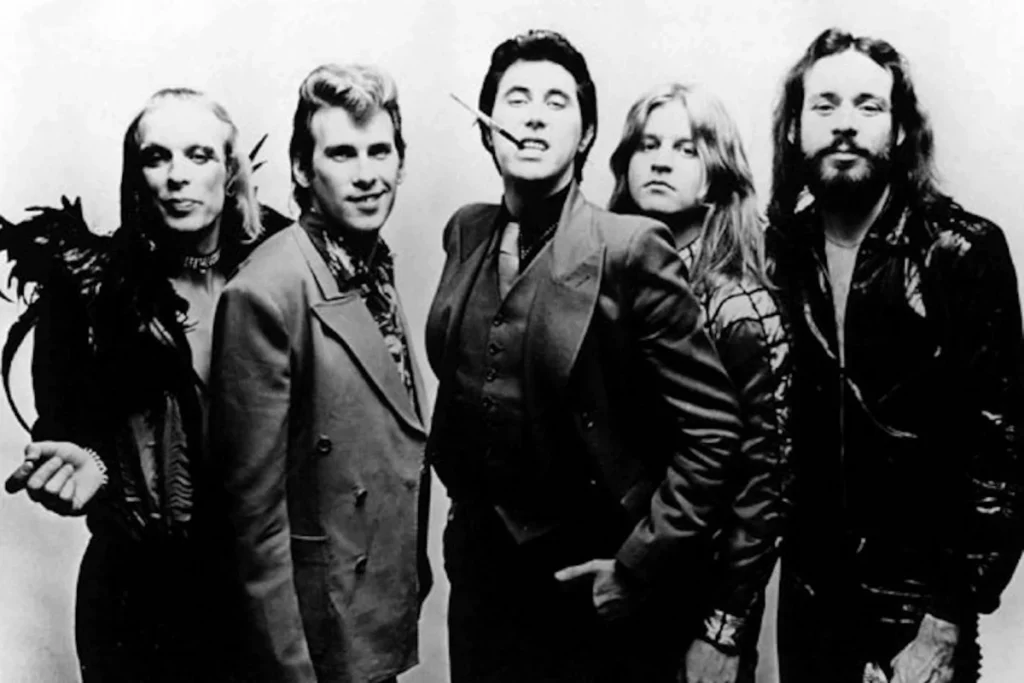
Formation and Philosophy
Roxy Music was formed in 1970 by Bryan Ferry, who envisioned a band that would merge the energy of rock music with the sensibilities of art school. Ferry, along with a group of musicians who each brought their own unique flair—including Brian Eno with his experimental electronic techniques, and Andy Mackay and Phil Manzanera with their classical and rock influences, respectively—created a sound that was at once familiar and strikingly novel.
This collective aimed not just to produce music but to craft a total artistic expression where fashion, album cover art, and stage performances were as integral as the music itself. They drew inspiration from a myriad of sources, from the avant-garde pop of the Beatles to the stylings of mod fashion, synthesizing these elements into a coherent yet eclectic presentation that pushed the boundaries of rock music.
Debut Impact
The release of their self-titled debut album in 1972 marked a significant moment in the glam rock movement. “Roxy Music” was not just an album; it was a declaration of a new era in rock music. The record was a smorgasbord of sounds and styles, featuring elements of classical arrangements, futuristic electronic music, and soulful melodies, all packaged in a distinctly glamorous rock ‘n’ roll aesthetic. Songs like “Virginia Plain,” which was not included on the original UK release but quickly became a hit single, showcased the band’s ability to blend catchy pop sensibilities with experimental soundscapes.
The album’s impact was immediate and profound. It reached the top ten in the UK Albums Chart, signaling a commercial success that matched its critical acclaim. More importantly, Roxy Music’s debut shifted the trajectory of glam rock by introducing a level of sophistication and artistry that was unprecedented in the genre. They brought a new focus on album art and stage sets, heavily influencing how music was experienced visually. The band’s approach to blending high art with popular music not only set them apart from their peers but also raised the bar for what could be expected from rock performances, making the music scene richer and more varied.
Innovation and Stylistic Contributions
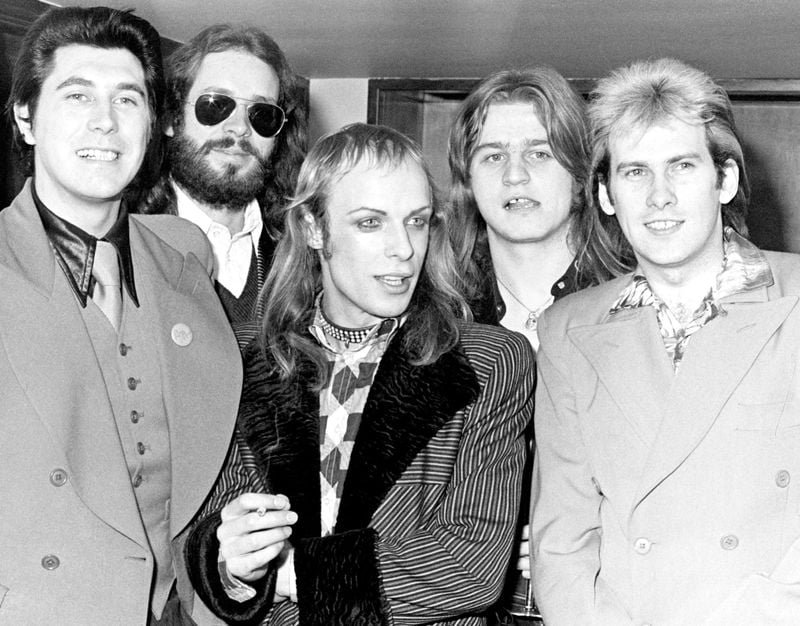
Musical Style
Roxy Music’s unique sound was a kaleidoscopic tapestry that defied easy categorization. Their music was an innovative fusion of rock, pop, and electronic music, peppered with elements of avant-garde and classical influences. This eclectic mix was not just a novelty but a sophisticated development of the glam rock sound. The band’s approach to music creation was groundbreaking, incorporating Brian Eno’s pioneering use of synthesizers and tape effects that enriched their texture. Their use of the synthesizer, in particular, was not just as background filler but as a central feature that added a futuristic sheen to their tracks.
Each album marked a progression in style, with early works characterized by experimental soundscapes that gradually evolved into more streamlined, yet still distinctive, compositions. Songs like “Do the Strand” and “Editions of You” from their second album, “For Your Pleasure,” exemplify this blend—rock and roll energy fused with lyrical and musical sophistication, creating tracks that were both danceable and thought-provoking. Roxy Music’s sound was both a continuation and a departure from traditional rock, pushing the boundaries of what music could convey in terms of both emotion and intellectual complexity.
Visual and Performance Art
Visually, Roxy Music was at the vanguard of what would become essential elements of glam rock. The band’s visual aesthetics were as integral to their identity as their music. Their album covers, designed with a keen eye for fashion and style, featured high glamour and sophistication, often depicting the band in various avant-garde and stylish poses. These covers were not just promotional materials but artworks that communicated the essence of the band’s music.
On stage, Roxy Music’s performances were theatrical events that combined music with drama and spectacle, a trait that became a hallmark of glam rock. Bryan Ferry, often dressed in extravagant outfits, played the role of the classic crooner with a modern twist, while the rest of the band complemented this with their charismatic and stylized performances. Their live shows were immersive experiences, utilizing innovative lighting, multimedia projections, and theatrical staging that enhanced the impact of their music and created a lasting impression on audiences.
This emphasis on visual and performance art not only set Roxy Music apart from their contemporaries but also deeply influenced the core aspects of glam rock. The band elevated the concert from a mere musical performance to a sensory spectacle, influencing countless artists in glam rock and beyond to consider their visual presentation as an extension of their musical artistry. Through their innovative blend of music, style, and performance, Roxy Music expanded the artistic possibilities of the genre, leaving an indelible mark on the landscape of popular music.
Key Albums and Tracks Influencing Glam Rock
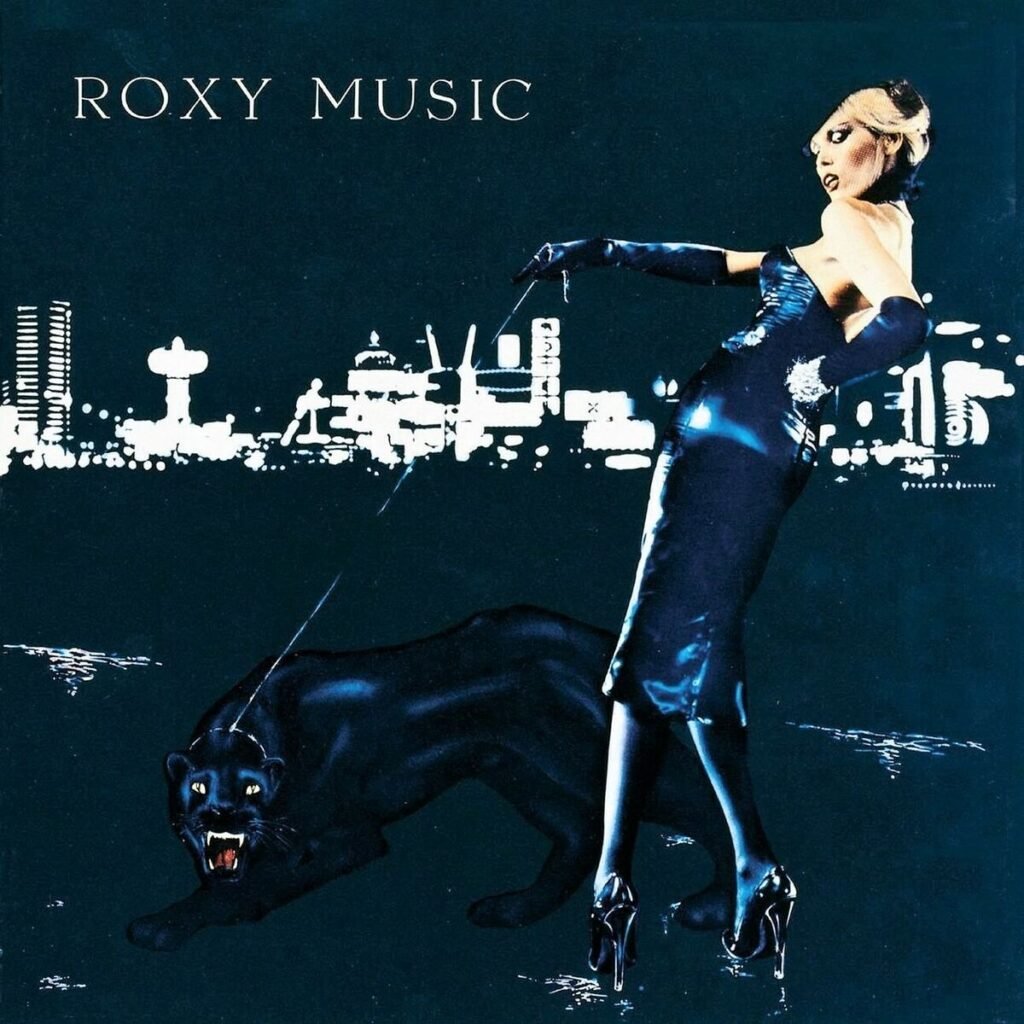
Influential Albums
Two of Roxy Music’s early albums, “For Your Pleasure” (1973) and “Stranded” (1973), are particularly noteworthy for their role in solidifying the band’s status within the glam rock movement and influencing its development. “For Your Pleasure” marks a pinnacle in the band’s explorative journey into sound and aesthetics. This album refined their experimental edge with a polished sophistication, exemplifying how avant-garde music could coexist with pop sensibilities. Its dark, moody tones, combined with lyrical narratives that range from the romantic to the surreal, present a rich tapestry of sound and emotion that pushed the boundaries of rock music at the time.
“Stranded,” the first album after Brian Eno’s departure, showcased the band’s ability to evolve, introducing a more streamlined sound while maintaining their distinctive style. The album includes some of Roxy Music’s most lush and evocative work, characterized by elaborate musical arrangements and sumptuous production. With tracks that blend rock’s drive with soulful melodies and intricate harmonies, “Stranded” not only captured the essence of glam rock but also expanded its reach by proving that glam could be both flamboyant and refined.
Transformational Tracks
Among the many standout tracks from these albums, “Do the Strand” from “For Your Pleasure” and “Editions of You” are particularly influential. “Do the Strand” is an anthem of the glam rock era, encapsulating the movement’s ethos with its celebratory tone and lyrics that invoke a dance nobody had seen before. The song is driven by a vibrant piano riff and a dynamic arrangement that seamlessly integrates a variety of instruments, making it a staple of the genre’s push towards blending diverse musical elements.
“Editions of You,” another track from the same album, showcases the band’s innovative use of synthesizers and theatrical elements. The song features a fast-paced, energetic rhythm section complemented by an aggressive synthesizer line that adds a distinctively futuristic feel. The theatrical delivery of the lyrics, combined with the song’s complex structure, exemplifies Roxy Music’s flair for drama and spectacle in music.
Both tracks not only highlight Roxy Music’s role in defining the sonic and aesthetic parameters of glam rock but also demonstrate how they continually pushed these boundaries. Their inventive use of electronic instruments and embrace of theatrical elements in these songs influenced subsequent artists within the genre, encouraging a more experimental approach to both music production and performance style in rock music.
Cultural Impact within Glam Rock
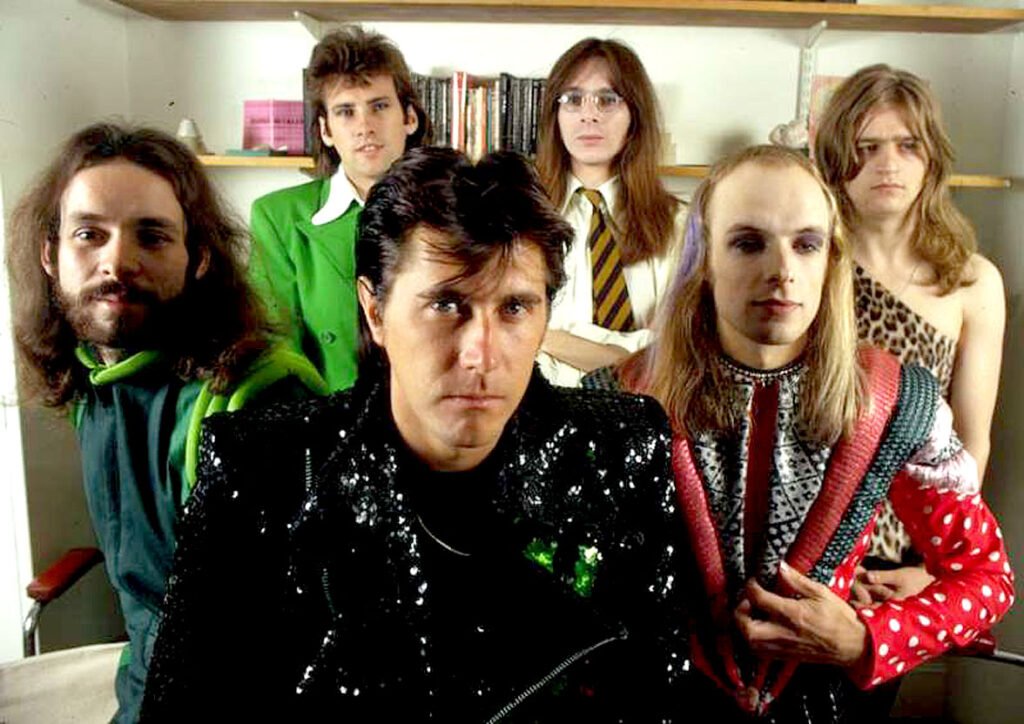
Fashion Innovations
Roxy Music’s influence on fashion within the glam rock movement was as transformative as their music. Their sartorial choices reflected a distinctive blend of retro and futuristic styles, setting them apart from their contemporaries. The band’s fashion sense was a deliberate part of their artistic expression, often curated to enhance their musical themes and the personas they embodied onstage. Anthony Price, their costume designer, played a crucial role in shaping the band’s visual identity, creating outfits that merged high fashion with avant-garde flair.
The members of Roxy Music frequently appeared in elaborate, sometimes outlandish costumes that included feather boas, sequined jackets, and sharp, tailored suits that harked back to the golden age of Hollywood while projecting a modern, androgynous edge. These fashion statements made by the band went beyond mere performance attire; they influenced the everyday styles of their fans, encouraging a flamboyant, expressive approach to personal fashion. Moreover, their impact was felt across the glam rock genre, with other bands adopting similarly theatrical styles that blurred traditional gender norms and pushed the boundaries of what rock musicians could wear both on and off the stage.
Theatrical and Cinematic Influence
Roxy Music’s approach to performance was theatrical and cinematic, often incorporating elements of drama and storytelling into their live shows. This aspect of their artistry was groundbreaking in the rock scene and had a lasting influence on how live music was presented in the glam rock genre and beyond. Their concerts were elaborate spectacles that featured dramatic lighting, multimedia projections, and carefully choreographed movements, turning each performance into an immersive experience.
The band’s influence extended to the development of music videos, where their emphasis on visual style and narrative depth set a precedent for the medium. Roxy Music understood the power of the visual image to complement and enhance their music, and this foresight proved prescient in the era of MTV and music video channels. Other glam rock bands took cues from Roxy Music’s integration of theatrical elements into their performances, increasingly focusing on the visual impact of their shows and the storytelling potential of their music videos.
Through their innovative approach to fashion and performance, Roxy Music significantly shaped the cultural dimensions of the glam rock movement. Their legacy in these areas can be seen in the continued importance of visual style and theatrical presentation in rock music, confirming their status as pioneers who not only participated in but profoundly influenced the cultural fabric of their time.
Final Thoughts
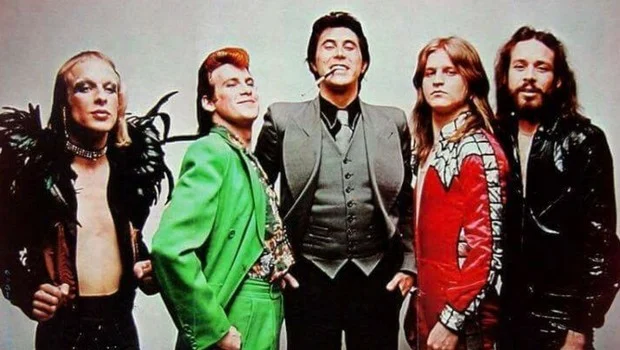
Synthesis of Contributions
Roxy Music’s impact on the glam rock genre and the broader landscape of popular music is both profound and multifaceted. Their innovative approach to music creation, characterized by a blend of rock, pop, and electronic influences, alongside sophisticated avant-garde elements, expanded the sonic possibilities of glam rock. This eclectic mix not only redefined what glam rock could sound like but also influenced the genre’s evolution into a more artistically rich and diverse musical category. Roxy Music’s dedication to integrating art and fashion into their musical expression further solidified their role as trailblazers in the music scene, blurring the lines between audio and visual artistry.
Their theatrical performance style, which brought drama and spectacle to live shows, transformed concert stages into arenas where narrative and music coexisted seamlessly. This approach did not just enhance their own performances but also set new standards for live music presentation, influencing countless artists and bands in glam rock and other genres to prioritize visual spectacle as an integral part of musical performance.
Their Place in Music History
Reflecting on Roxy Music’s place in music history, their legacy extends far beyond their original era and genre. As pioneers of glam rock, they left an indelible mark on the visual and musical style of the 1970s, but their influence is timeless and can be traced through various movements and styles that followed. Their experimental use of synthesizers and studio techniques paved the way for electronic and new wave bands in the 1980s and beyond, while their fusion of different musical styles forecasted the genre-blending practices of contemporary music.
The band’s integration of high fashion and theatrical elements into rock music anticipated the later trends of music videos and stage performances, demonstrating an understanding of the power of multimedia in music promotion and consumption that would become standard in the industry. Roxy Music not only participated in but shaped the cultural and musical narratives of their time, their innovative spirit ensuring that their influence would continue to resonate through generations.
In sum, Roxy Music’s contributions to music are enduring and dynamic. They redefined the possibilities of glam rock and set precedents that have influenced the artistic direction of music for decades. As such, Roxy Music remains a seminal force, celebrated not just for their historical contributions but for their ongoing relevance in the rich tapestry of music history.
